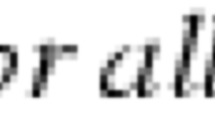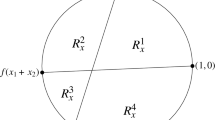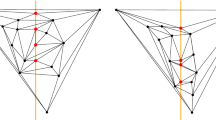Abstract
We introduce a new combinatorial object, the double-permutation sequence, and use it to encode a family of mutually disjoint compact convex sets in the plane in a way that captures many of its combinatorial properties. We use this encoding to give a new proof of the Edelsbrunner-Sharir theorem that a collection of n compact convex sets in the plane cannot be met by straight lines in more than 2n-2 combinatorially distinct ways. The encoding generalizes the authors’ encoding of point configurations by “allowable sequences” of permutations. Since it applies as well to a collection of compact connected sets with a specified pseudoline arrangement \( \mathcal{A} \) of separators and double tangents, the result extends the Edelsbrunner-Sharir theorem to the case of geometric permutations induced by pseudoline transversals compatible with \( \mathcal{A} \).
Similar content being viewed by others
References
S. Basu, J. E. Goodman, A. Holmsen and R. Pollack: The Hadwiger transversal theorem for pseudolines, in: Combinatorial and Computational Geometry (J. E. Goodman, J. Pach and E. Welzl, eds.), Math. Sci. Res. Inst. Publ. 52, Cambridge Univ. Press, Cambridge, 2005, pp. 79–85.
A. Björner, M. Las Vergnas, B. Sturmfels, N. White and G. M. Ziegler: Oriented Matroids, 2nd Ed., Volume 46 of Encyclopedia of Mathematics, Cambridge Univ. Press, 1999.
J. Eckhoff: Helly, Radon, and Carathéodory type theorems; in: Handbook of Convex Geometry (P. M. Gruber and J. M. Wills, eds.), Volume A, North-Holland, Amsterdam, 1993, pp. 389–448.
H. Edelsbrunner and M. Sharir: The maximum number of ways to stab n convex noninstersecting sets in the plane is 2n-2, Discrete Comput. Geom. 5 (1990), 35–42.
J. E. Goodman: Proof of a conjecture of Burr, Grünbaum, and Sloane; Discrete Math. 32 (1980), 27–35.
J. E. Goodman: Pseudoline arrangements, in: Handbook of Discrete and Computational Geometry (J. E. Goodman and J. O’Rourke, eds.), 2nd edition, CRC Press, Boca Raton, 2004, pp. 97–128.
J. E. Goodman and R. Pollack: On the combinatorial classification of nondegenerate configurations in the plane, J. Combin. Theory, Ser. A 29 (1980), 220–235.
J. E. Goodman and R. Pollack: Proof of Grünbaum’s conjecture on the stretchability of certain arrangements of pseudolines, J. Combin. Theory, Ser. A 29 (1980), 385–390.
J. E. Goodman, R. Pollack and R. Wenger: Geometric transversal theory, in: New Trends in Discrete and Computational Geometry (J. Pach, ed.), Volume 10 of Algor. Combin., Springer-Verlag, Berlin, 1993, pp. 163–198.
J. E. Goodman, R. Pollack, R. Wenger and T. Zamfirescu: Arrangements and topological planes, Amer. Math. Monthly 101 (1994), 866–878.
B. Grünbaum: The importance of being straight, in: Proc. 12th Biennial Sem. Canad. Math. Congr. on Time Series and Stochastic Processes, Convexity and Combinatorics, (Vancouver, B.C.), 1969, Canad. Math. Congr., Montreal, pp. 243–254.
B. Grünbaum: Arrangements and Spreads, Volume 10 of CBMS Regional Conf. Ser. in Math., Amer. Math. Soc., Providence, 1972.
M. Katchalski, T. Lewis and J. Zaks: Geometric permutations for convex sets, Discrete Math. 54 (1985), 271–284.
F. W. Levi: Die Teilung der projektiven Ebene durch Gerade oder Pseudogerade, Ber. Math.-Phys. Kl. Sächs. Akad. Wiss. 78 (1926), 256–267.
L. Lovász, K. Vesztergombi, U. Wagner and E. Welzl: Convex quadrilaterals and k-sets, in: Towards a Theory of Geometric Graphs (J. Pach, ed.), Contemp. Math. 342, Amer. Math. Soc., Providence, 2004, pp. 139–148.
J. Pach and R. Pinchasi: On the number of balanced lines, Discrete Comput. Geom. 25 (2001), 611–628.
M. Sharir and P. K. Agarwal: Davenport-Schinzel Sequences and Their Geometric Applications, Cambridge Univ. Press, New York, 1995.
R. Wenger: Helly-type theorems and geometric transversals, in: Handbook of Discrete and Computational Geometry (J. E. Goodman and J. O’Rourke, eds.), 2nd edition, CRC Press, Boca Raton, 2004, pp. 73–96.
Author information
Authors and Affiliations
Corresponding author
Additional information
Supported in part by NSA grant MDA904-03-I-0087 and PSC-CUNY grant 65440-0034.
Supported in part by NSF grant CCR-9732101.
Rights and permissions
About this article
Cite this article
Goodman, J.E., Pollack, R. The combinatorial encoding of disjoint convex sets in the plane. Combinatorica 28, 69–81 (2008). https://doi.org/10.1007/s00493-008-2239-7
Received:
Published:
Issue Date:
DOI: https://doi.org/10.1007/s00493-008-2239-7




